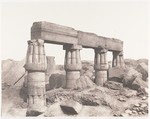Karnak (Thèbes), Palais - Partie Posterieure - Fragment de Colonnades Vu du Point S
Félix Teynard French
Printer Imprimerie Photographique de H. de Fonteny et Cie
Not on view
Photography was scarcely a decade old when Félix Teynard set out for Egypt in 1851, equipped with a large-format camera and the paper-negative technique perfected only the year before in Paris by Gustave Le Gray. A civil engineer who practiced in Grenoble, Teynard visited Egypt expressly to make a photographic companion to Description de l’Egypte, the lavish publication issued by Napoleon’s team of savants between 1809 and 1829. Teynard understood that the engravings in the book, however grand, were inadequate; they could not compete with photography’s direct apprehension of the visual experience of a place.
Teynard’s ouvre consists exclusively of the one hundred and sixty plates of his book, Egypte et Nubie (1853-58) which reveal an uncommon grasp of the physicality of man-made constructions: their size and placement in space, their materials and decoration, and their state of conservation, destruction, or desecration. Here, the papyrus columns, like new plant shoots emerging from resourceful roots, seem less a study of architecture than the very picture of survival.
This image cannot be enlarged, viewed at full screen, or downloaded.

